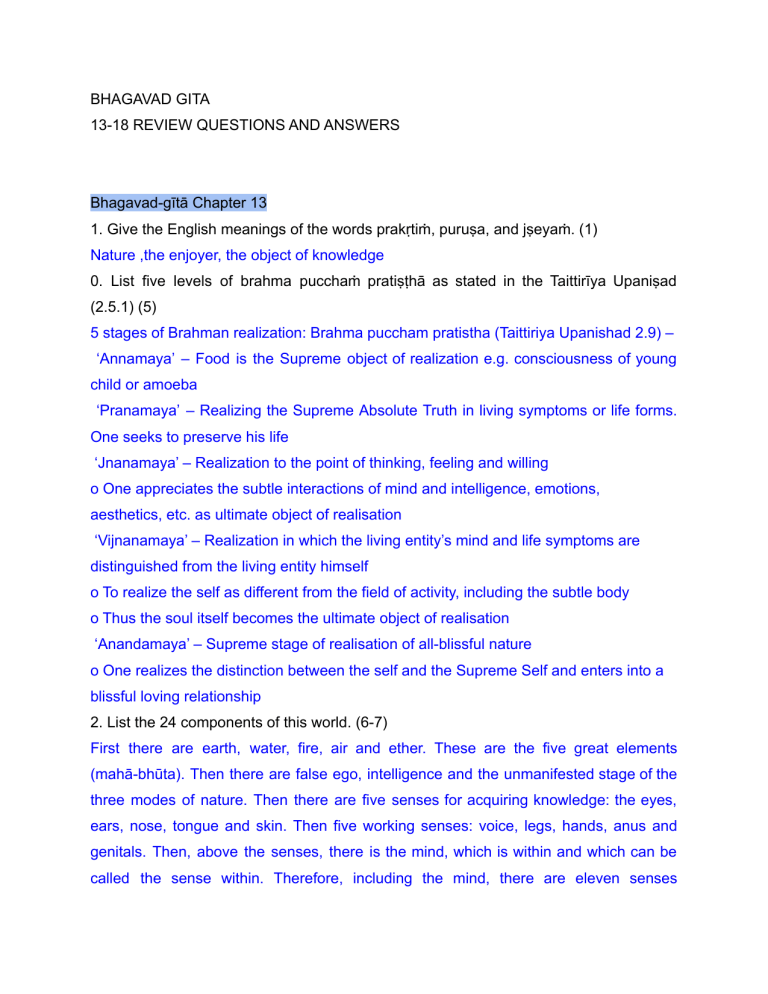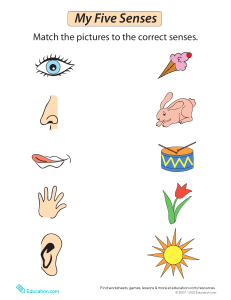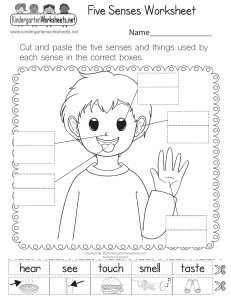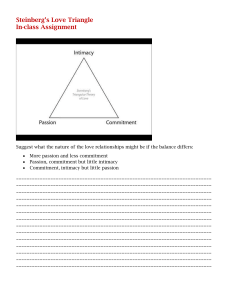
BHAGAVAD GITA 13-18 REVIEW QUESTIONS AND ANSWERS Bhagavad-gītā Chapter 13 1. Give the English meanings of the words prakṛtiṁ, puruṣa, and jṣeyaṁ. (1) Nature ,the enjoyer, the object of knowledge 0. List five levels of brahma pucchaṁ pratiṣṭhā as stated in the Taittirīya Upaniṣad (2.5.1) (5) 5 stages of Brahman realization: Brahma puccham pratistha (Taittiriya Upanishad 2.9) – ‘Annamaya’ – Food is the Supreme object of realization e.g. consciousness of young child or amoeba ‘Pranamaya’ – Realizing the Supreme Absolute Truth in living symptoms or life forms. One seeks to preserve his life ‘Jnanamaya’ – Realization to the point of thinking, feeling and willing o One appreciates the subtle interactions of mind and intelligence, emotions, aesthetics, etc. as ultimate object of realisation ‘Vijnanamaya’ – Realization in which the living entity’s mind and life symptoms are distinguished from the living entity himself o To realize the self as different from the field of activity, including the subtle body o Thus the soul itself becomes the ultimate object of realisation ‘Anandamaya’ – Supreme stage of realisation of all-blissful nature o One realizes the distinction between the self and the Supreme Self and enters into a blissful loving relationship 2. List the 24 components of this world. (6-7) First there are earth, water, fire, air and ether. These are the five great elements (mahā-bhūta). Then there are false ego, intelligence and the unmanifested stage of the three modes of nature. Then there are five senses for acquiring knowledge: the eyes, ears, nose, tongue and skin. Then five working senses: voice, legs, hands, anus and genitals. Then, above the senses, there is the mind, which is within and which can be called the sense within. Therefore, including the mind, there are eleven senses altogether. Then there are the five objects of the senses: smell, taste, form, touch and sound. These twenty-four elements are called the field of activity. 3. List, in Sanskrit or English, ten of the 20 items of knowledge. (8-12) Humility; pridelessness; nonviolence; tolerance; simplicity; approaching a bona fide spiritual master; cleanliness; steadiness; self-control; renunciation of the objects of sense gratification; absence of false ego; the perception of the evil of birth, death, old age and disease; detachment; freedom from entanglement with children, wife, home and the rest; even-mindedness amid pleasant and unpleasant events; constant and unalloyed devotion to Me; aspiring to live in a solitary place; detachment from the general mass of people; accepting the importance of self-realization; and philosophical search for the Absolute Truth Bhagavad-gītā Chapter 14 4. What is the mahat-tattva? (3) The mahat-tattva is the total cause of the total cosmic manifestation; and that total substance of the material cause, in which there are three modes of nature, is sometimes called Brahman. 5. How do those situated in the mode of goodness become conditioned? (6) The difficulty here is that when a living entity is situated in the mode of goodness he becomes conditioned to feel that he is advanced in knowledge and is better than others. In this way he becomes conditioned. The best examples are the scientist and the philosopher. Each is very proud of his knowledge, and because they generally improve their living conditions, they feel a sort of material happiness. 6. The mode of passion is characterized by what? (7) The mode of passion is characterized by the attraction between man and woman. Woman has attraction for man, and man has attraction for woman. This is called the mode of passion. And when the mode of passion is increased, one develops the hankering for material enjoyment 7. List 3 results of the mode of ignorance. (8) The results of this mode are madness, indolence and sleep, which bind the conditioned soul. 8. Those situated in goodness, passion, and ignorance progress in which directions? (18) Those situated in the mode of goodness gradually go upward to the higher planets; those in the mode of passion live on the earthly planets; and those in the abominable mode of ignorance go down to the hellish worlds. Bhagavad-gītā Chapter 15 9. Give the English meaning of ūrdhva-mūlam and adhaḥ-śākham. (1) With roots above and branches downwardsh 10. What do the leaves of the banyan tree refer to? (1) Leaves are the Vedic hymns 11. What is the tree of the material world situated on? (1) This tree is situated on desire. 12. This banyan tree is nourished by what? (2) The branches of this tree extend downward and upward, nourished by the three modes of material nature. 13. Give the English meaning of asaṅga-śastreṇa. (3-4) by the weapon of detachment 14. Give three examples of how Kṛṣṇa maintains this material world. (12 -14) Splendor of the sun, moon, electricity and fire come from Supreme Personality of Godhead. The Lord holds the earth which gives vegetables. Vegetables are nourished by moonshine which comes from the Lord. To digest we need Krishna’s energy as fire and life airs (outgoing and incoming) 15. What do the words kṣaraḥ and akṣaraḥ refer to? (16) Fallible and infallible 16. What does the word puruṣottamam refer to? (19) The Supreme Personality of Godhead Bhagavad-gītā Chapter 16 17. Give the English meaning of the following words: sampadaṁ (1-3), pravṛtti and nivṛtti (7), anīśvaram (8), and ugra-karmāṇaḥ. (9) The qualities, acting properly and not acting improperly, with no controller ,engaged in painful activities 18. Who was the best example of a demoniac man? (16) The best example of such a demoniac man was Rāvaṇa. 19. Give the English meaning of mām aprāpyaiva kaunteya. (20) Never attain me, o son of Kunti 20. List the three gates leading to hell. (21) There are three gates leading to this hell – lust, anger and greed Bhagavad-gītā Chapter 17 21. Name the three kinds of faith (2) one’s faith can be of three kinds – in goodness, in passion or in ignorance 22. List the six results of eating food in the mode of goodness. (8) Foods dear to those in the mode of goodness increase the duration of life, purify one’s existence and give strength, health, happiness and satisfaction. 23. Austerity of the body consists of what eight items? (14) Austerity of the body consists in worship of the Supreme Lord, the brāhmaṇas, the spiritual master, and superiors like the father and mother, and in cleanliness, simplicity, celibacy and nonviolence. 24. Give the English meaning of svādhyāya abhyasanam. (15) Practice of vedic study 25. List four symptoms of charity in the mode of goodness. (20) Charity given out of duty, without expectation of return, at the proper time and place, and to a worthy person is considered to be in the mode of goodness 26. The three words oṁ tat sat indicate what? (23) From the beginning of creation, the three words oṁ tat sat were used to indicate the Supreme Absolute Truth. Bhagavad-gītā Chapter 18 28. List symptoms of renunciation in the mode of passion. (8) Renunciation in the mode of passion ❖ Giving up prescribed duties as troublesome or out of fear of bodily discomfort ❖ Examples: In Krishna consciousness, giving up earning money out of fear that it is fruitive activity is not recommended, one should engage his money in Krishna consciousness Rising early in the morning may be troublesome ❖ Result of passionate work is always miserable – One does not elevate in renunciation 29. List the five causes for the accomplishment of all action. (14) The place of action [the body], the performer, the various senses, the many different kinds of endeavor, and ultimately the Supersoul – these are the five factors of action. 30. List three symptoms of happiness in the mode of goodness. (37) Happiness in goodness ❖ Like poison in the beginning and nectar in the end Many rules and regulations to control mind and senses may appear bitter like poison Successful transcendental realisation is like nectar ❖ Awakens one to self-realisation 31. List three symptoms of happiness in the mode of passion. (38) Happiness in passion ❖ Derived from contact of senses with the sense objects ❖ Like nectar at first but poison at the end e.g. Young woman and young man meet and senses drive one to see, touch and have sexual intercourse (like nectar) – at the end there may be separation, divorce, lamentation etc. (like poison) 32. List five symptoms of happiness in the mode of ignorance (39) Happiness which is blind to self-realization, which is delusion from beginning to end and which arises from sleep, laziness and illusion is said to be of the nature of ignorance. 33. List nine qualities by which the brāhmaṇas work. (42) Peacefulness, self-control, austerity, purity, tolerance, honesty, knowledge, wisdom and religiousness – these are the qualities by which the brāhmaṇas work. 34. List six symptoms of surrender in Sanskrit or English (66) 1. Simply accept such religious principles that are favorable to devotional service 2. Avoid anything unfavorable to devotional service 3. Confidence of Krishna’s protection in all circumstances 4. No need of thinking how to keep body and soul together. Krishna will see to that 5. Always think oneself helpless 6. Consider Krishna as the only basis of one’s progress in life 35. This confidential knowledge may never be explained to whom? (67) Do not teach Bhagavad-gita to one who is: ❖ Not austere ❖ Not devoted to Krishna’s service ❖ Envious of Krishna




